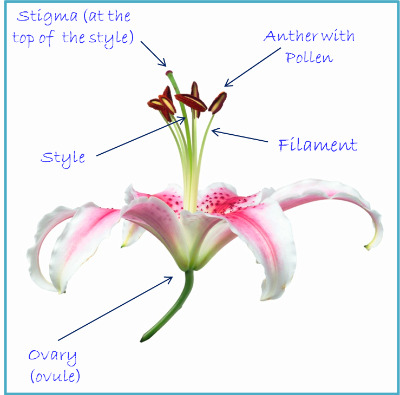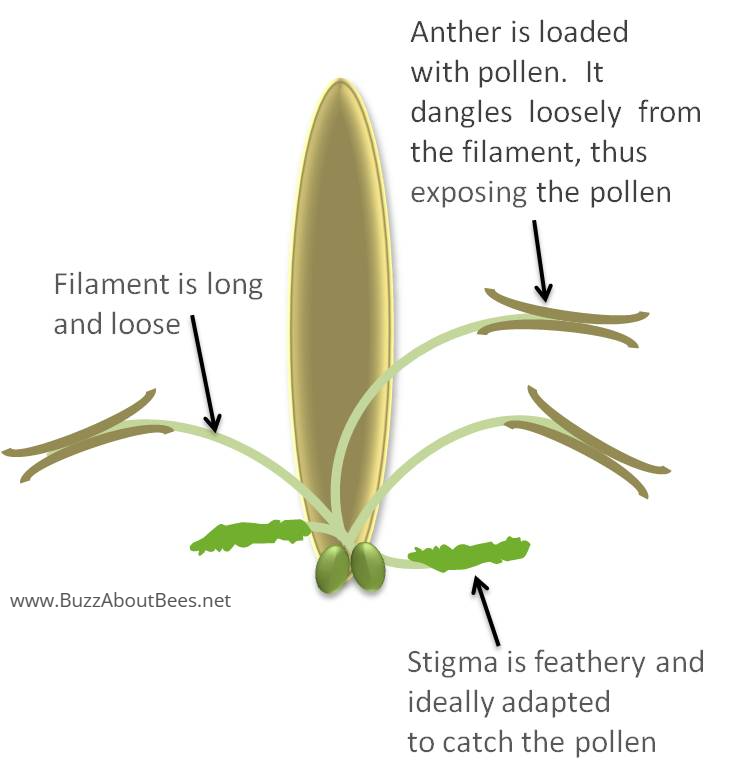The Plant Pollination Process
Updated: November 2023
The plant pollination process describes the vital method of sexual
reproduction in plants. It enables a plant to bear fruit and seeds,
many of which are not only eaten by humans, but also by other living
species from birds to mammals. Birds and mammals may then distribute
those seeds to new geographical locations through their droppings.
The Plant Pollination Process
The pollination process involves the transfer of pollen, from the male part of a plant (in flowers, this is the ‘stamen’) to the female part of the plant (the 'carpel').
The pollen contains male
sperm (gametes), and the carpel is where the female gametes are
contained.
The photograph of a lily below clearly shows:
- the male part of the flower: comprising the anther and filament (together, called the ‘stamen’); and
- the female part of the flower: the stigma and style with the ovary (containing the ovule) at the base of the flower (the ‘carpel').
4 key steps in pollination
The following 4 stages of the pollination process correspond to the graphic above.
- A pollen grain lands on the sticky stigma.
- A pollen tube grows from the pollen grain, and down the style, carrying a male gamete with it down the tube to meet the female gamete in an ovule.
- The male and female gamete fuse and fertilization occurs.
- The ovule develops into seed, and the ovary develops into fruit that will protect the seed.
A pollen grain on the stigma grows a tiny tube, all the way down the style to the ovary. This pollen tube carries a male gamete to meet a female gamete in an ovule.
In a process called fertilisation, the two gametes join and their chromosomes combine, so that the fertilised cell contains a normal complement of chromosomes, with some from each parent flower.
How pollination forms seeds
The fertilised ovule goes on to form a seed, which contains a food store and an embryo that will later grow into a new plant.
Some plants, have many or multiple ovules in their ovary, resulting in a fruit with many or multiple seeds, such as watermelons, pears, oranges or apples.
How pollination forms fruits
The ovary develops into a fruit to protect the seed. Some flowers, such as avocados, only have one ovule in their ovary, so their fruit only has one seed. Many flowers, such as kiwifruit, have lots of ovules in their ovary, so their fruit contains many seeds.
In most cases, more than one individual plant is needed. This means that pollen is transferred from one plant, to another individual plant.
This, in a nutshell is
‘cross pollination’.
However, some plants have evolved the ability to
self pollinate.
‘Self pollination’ means that an individual flower on a plant stem can
pollinate itself or other flowers on the same individual plant stem.
Where plants need other plants, how does this transference of pollen occur?
Biotic Pollination
About
80% of plant pollination requires the help of other living, moving
creatures such as insects, birds, or bats, to transfer pollen from one
plant to another.
This is called ‘biotic pollination’.

Where this is the case, plants are adapted to encourage the specific pollinators they need and are said to have developed 'pollination syndromes'.
Very
often, the pollinating creature will receive some form of reward, as an incentive to visit the plant. The reward might be a portion of
the nectar or pollen produced by that plant specimen.
Of course,
insects such as bees require nectar and pollen for food - you can read
more about this on the page:
Why Do Bees Need Nectar And Pollen?
However, this is not always the case, and the insects do not always
get the desired reward! Some plants it seems, have devised cunning
ways to cheat the very creature it needs for the pollination process to
occur.
In other words, the creature (usually an insect) enters a
flower and thereby pollinates it, only to discover there is no reward
at the end of their endeavor!
That said, it works both ways. Some insects including bees, have devised ways of robbing nectar without pollinating the plant at all.
You can read more about this on my page describing
flower pollination.
Abiotic Pollination
What about the other 20% of plants, how are they pollinated?
Well some plants, especially grasses, most conifers, and some deciduous trees, are pollinated by wind.
This is called ‘anemophily’.
The structure of the plant is adapted to enable pollen grains to be blown from one plant onto another.
However, a small number of plants – water plants - rely on water movement for pollination.
This is called ‘hydrophily’.






